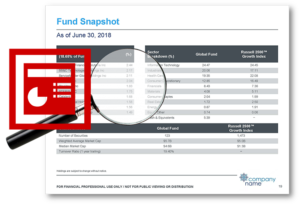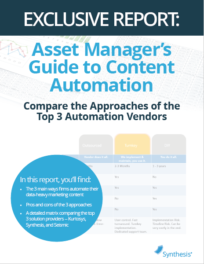Key Findings from our Second-Annual Investment Marketing Roundtable

In May 2017, we hosted a private roundtable, moderated by Candyce Edelen of PropelGrowth. At the table were 15 senior marketers from various investment management firms. This was our second annual event, with about half of the participants returning from last year. The participant firms included boutique asset managers, medium-sized regional and global investment firms, and 3 of the top 20 global asset managers. AUM for the firms represented ranges from $20 Billion to more than $2 Trillion. All of the participants serve multiple channels including institutional (trusts, foundations, pensions, corporations, etc.), intermediary and direct retail advisor channels.
The goal of the event was to bring together experienced marketers and give us an open forum in which to learn from each other.
Discussion Topics
Topics we discussed included:
• Customer-centric versus investment-centric marketing
• Marketing strategy in terms of branding, thought leadership and sales support
• Lead generation, nurturing and account-based marketing
• Marketing alignment with sales, compliance, and brand marketing
• Marketing technology, budgets and the very painful buying process
• Analytics and tracking ROI
Key Takeaways
Here are some of our key takeaways from the event:
Firms are moving toward a more customer-centric focus
Roughly half the firms have moved to a more customer-centric focus, instead of focusing their content exclusively on investment products. The firms that are investment-centric tend to focus on the “nitty-gritty” aspects of their investment strategies. But this doesn’t always serve the customer well. One marketer says she constantly asks her team, “What does that mean to the customer? How are they going to get interested? Why do they care about that?”
The firms that are moving to a more customer-centric approach are focusing on those key questions. They’re realizing that their best revenue opportunities come from existing clients. So they’re becoming more relationship-focused. Interestingly, this is also motivating the product teams. As they learn more about the customers’ goals, they’re getting more excited to attend client meetings and communicate in a more customer-centric manner. It will take time for firms to fully make this shift, but in the end, the customer will be the beneficiary; and it will allow firms to differentiate more effectively.
Different channels respond differently
Marketers are realizing that institutional, intermediary and advisor clients respond very differently to marketing outreach. So they’re beginning to find ways to tweak their programs to maximize response. In the course of the discussions, I noticed much more collaboration with Sales than we saw last year. This is a natural result of a firm moving to a customer-centric focus.
All of the firms struggle to different degrees with finding ways to market through intermediary channels. Fiduciary rules adopted by these intermediary firms continue to restrict how the marketing team promotes its products.
Alignment with Sales has improved
We did not spend as much time talking about sales/marketing alignment this year, but it was clear to me that the firms are all in various stages of improving the relationships between the two departments. Marketing appears to be working more closely with Sales to plan content and campaigns, especially in the firms that are moving to a customer-centric focus.
Alignment with Compliance is great
The entire group strongly agreed that they have great alignment with their Compliance teams. Most of them have Compliance on speed dial and have a good working relationship. They’re figuring out how to collaborate to develop marketing programs that meet the goals of both Compliance and Marketing. In many cases, Compliance has become Marketing’s ally when confronting unreasonable requests from the Sales team.
Alignment with Corporate Marketing…not so much
Most of the marketers, even at smaller firms, are struggling to align with the corporate marketing and branding groups. In some cases, the asset management business is part of a large commercial bank. This creates conflicts in brand identity and messaging. In other cases, there are cross-border conflicts.
Marketing is focusing attention on client retention
While our participants don’t have direct responsibility for client retention, they do provide content to support the departments responsible for client services. In nearly all cases, the marketers are providing content to support those departments, and in most cases, the content they’re creating is very specialized and client-centric.
Marketing Automation
Nearly all the participants are now using marketing automation, and it is integrated with their CRM. However, most do not have full visibility into the client lifecycle in the CRM. This is severely hampering marketers’ ability to evaluate the effectiveness of their campaigns and improve the ROI on marketing investments. The problems appear to be tied to enterprise implementations of CRM. Line-of-business marketing needs are not being considered when functional requirements are drawn up. Enterprise-level implementations end up diluting the tools so much that they become almost useless at the tactical level. This issue represents a opportunity for small and medium sized firms to differentiate their marketing while the large firms focus on efficiency at the cost of effectiveness.
Account-based marketing is a new frontier
Marketers are optimizing their strategies to make the most impact to revenue. All of them agreed that the best way to do this would be to focus just outside the top 20% of producers and try to move those to become part of the top 20%. Account-based strategies are still foreign to this group, so we talked a bit about how to shift their approach and target at key accounts. This will be a challenging learning curve, but promises to deliver a more significant ROI than traditional mass marketing methods.
You can download our full report here.
Not everything we discussed could be covered in the report, so I will be blogging on the other topics we discussed. You can find these and other roundtable thought leadership resources at www.synthesistechnology.com/roundtable
Want to be notified when we publish new posts from the Roundtable?
Subscribe here:








 Compare the Top 3 Finserv Content Automation Vendors [White paper]
Compare the Top 3 Finserv Content Automation Vendors [White paper] Create Pitchbooks the Drive Sales [White paper]
Create Pitchbooks the Drive Sales [White paper] Build vs. Buy: Should Your Financial Services Firm Outsource or Insource Marketing Technology? [White paper]
Build vs. Buy: Should Your Financial Services Firm Outsource or Insource Marketing Technology? [White paper]  10 Tips for Rebranding your Fund Marketing Documents [White paper]
10 Tips for Rebranding your Fund Marketing Documents [White paper]

